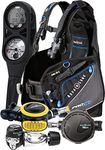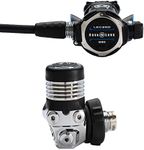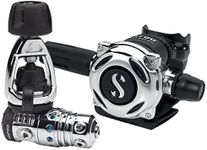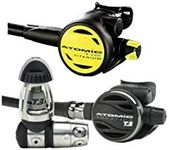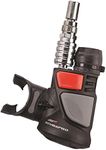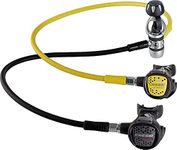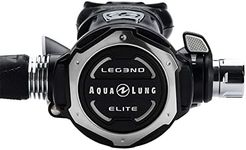Buying Guide for the Best Diving Regulators
Choosing the right diving regulator is crucial for ensuring a safe and enjoyable diving experience. A diving regulator is a device that allows you to breathe underwater by reducing the high-pressure air from your tank to a breathable pressure. When selecting a diving regulator, it's important to consider various specifications to find the best fit for your diving needs. Here are the key specs to look at and how to navigate them.First Stage TypeThe first stage of a diving regulator is the part that attaches to the tank and reduces the high-pressure air to an intermediate pressure. There are two main types: piston and diaphragm. Piston regulators are generally simpler and can offer better performance in warm water. Diaphragm regulators are more complex but are better suited for cold water diving as they are less likely to freeze. Choose a piston regulator if you primarily dive in warm waters and a diaphragm regulator if you dive in colder conditions.
Second Stage TypeThe second stage is the part of the regulator that you breathe from. It further reduces the intermediate pressure air to ambient pressure. There are balanced and unbalanced second stages. Balanced second stages provide consistent airflow regardless of tank pressure, making them more comfortable for deeper or longer dives. Unbalanced second stages are simpler and often more affordable but may require more effort to breathe from as tank pressure decreases. If you plan on deep or technical diving, a balanced second stage is recommended. For recreational diving, an unbalanced second stage may suffice.
Environmental SealingEnvironmental sealing is a feature that prevents water and contaminants from entering the first stage of the regulator. This is particularly important for cold water diving, as it helps prevent the regulator from freezing. If you dive in cold or contaminated waters, look for a regulator with environmental sealing. For warm, clear water diving, this feature may not be as critical.
Adjustable FeaturesSome regulators come with adjustable features such as inhalation effort control and venturi assist. Inhalation effort control allows you to adjust the breathing resistance, making it easier or harder to breathe based on your preference. Venturi assist helps direct airflow to reduce breathing effort. These features can enhance comfort and performance, especially on longer dives. If you value customization and comfort, look for regulators with these adjustable features.
WeightThe weight of the regulator can affect your overall comfort, especially if you travel frequently with your gear. Lighter regulators are easier to pack and carry, but they may be less durable. Heavier regulators are often more robust and can handle rougher conditions. Consider how often you travel and the type of diving you do when choosing the weight of your regulator.
Hose ConfigurationThe hose configuration refers to the number and placement of hoses on the first stage. Some regulators offer multiple low-pressure and high-pressure ports, allowing for more flexible hose routing. This can be important for technical diving or if you use additional equipment like a dry suit or a dive computer. If you need a specific hose setup, look for a regulator with a versatile hose configuration.
ServiceabilityServiceability refers to how easy it is to maintain and service the regulator. Some regulators are designed to be user-serviceable, while others require professional servicing. Regular maintenance is crucial for safety and performance. If you prefer to do your own maintenance, look for a regulator that is user-serviceable. Otherwise, ensure that you have access to professional servicing options.

